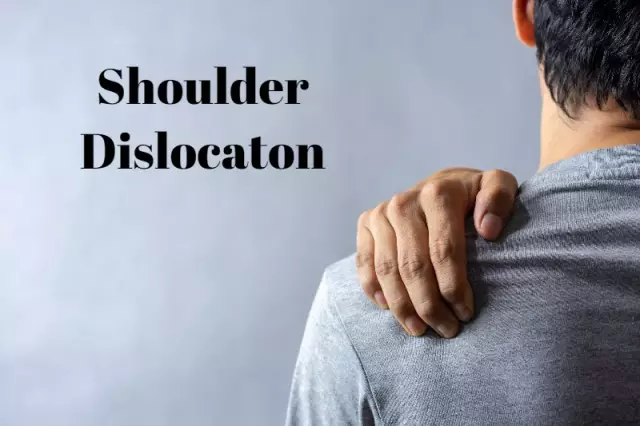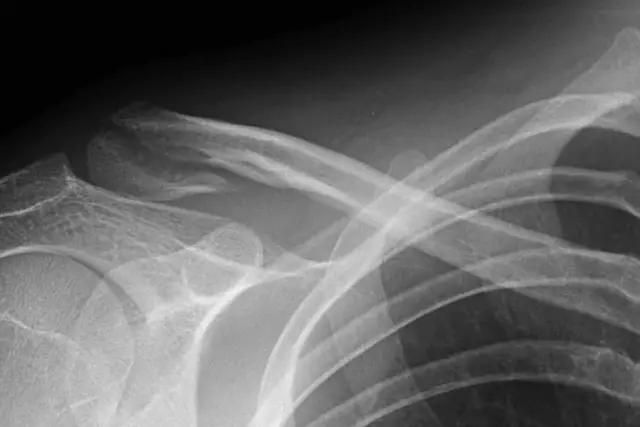- Author Rachel Wainwright [email protected].
- Public 2023-12-15 07:39.
- Last modified 2025-11-02 20:14.
Dislocation

Dislocations are a mutual displacement of the articular ends of the bones articulating with each other. Displacement of the joint during dislocation is persistent, with limited physiological mobility and pronounced pain syndrome.
Types of dislocations
Joint dislocations are divided into the following main types, depending on the nature of their occurrence:
Traumatic.
They arise as a result of mechanical impact on the joint, for example, when falling or hitting. This type of dislocation is usually accompanied by ruptures in the joint capsule. Traumatic dislocations are often complicated by bone fractures, infringement of soft tissues, damage to the skin, nerve endings and tendons.
Congenital.
This type of joint dislocation belongs to the pathologies of the development of the musculoskeletal system and occurs even at the intrauterine stage of fetal development. The most common congenital hip dislocation.
Pathological.
Pathological joint dislocations occur as a result of inflammatory processes and further destruction of the articular ends of the bones, under the influence of diseases such as osteomyelitis, tuberculosis, etc. Predictions and treatment tactics are primarily based on the treatment of the underlying disease, taking into account the maximum possible restoration of mobility of the affected joint.
Habitual.
The formation of habitual dislocation is most typical for the shoulder joint. Habitual dislocation of the shoulder is formed if, after the injury, the immobilization fixation of the joint was insufficient in time. A short period of immobilization leads to the fact that, as a consequence, dislocation of the shoulder occurs repeatedly, as a result of the slightest physical effort or careless movement. To eliminate the consequences of a habitual dislocation, the tactics of surgical intervention is usually chosen, aimed at normalizing the state of the ligamentous apparatus.
Dislocation reasons
The origin of dislocations can be both congenital (intrauterine dislocation of the hip) and acquired character (a consequence of trauma or inflammatory diseases of the tissues surrounding the joint).
The most common causes of joint dislocation are:
- a fall or blow, with a sharp contact of the joint with a hard surface, for example, a fall with a blow to the elbow causes a dislocation of the shoulder;
- a sharp and significant muscle contraction;
- physical impact on the joint itself or on the area adjacent to it;
- unnatural and strong extension or bending of the joint.
Dislocation symptoms

The most common symptoms of a dislocation include:
- at the moment of injury, a characteristic pop is heard;
- Edema and swelling form around the injured joint (the most common symptom of dislocation);
- sharp and severe soreness;
- bruising;
- with damage to nerve endings, decreased sensitivity;
- limitation of mobility;
- tingling and numbness;
- pale and cold skin;
- visual deformation, etc.
The specific symptoms of a dislocation differ from where the joint is injured.
Shoulder dislocation
Dislocations of the shoulder are among the most common types of dislocations of traumatic origin (according to statistics, more than half of all cases). This fact is explained by the peculiarities of the anatomical structure of the shoulder joint: the disproportionate ratio of the articular surfaces, the anterior muscular region that is not naturally strong enough, a significant range of motion in different planes, the volumetric capsule of the joint, etc.
Dislocation of the shoulder, as a rule, occurs as a result of indirect impact, when falling on the elbow or forearm, in almost one hundred percent of cases it is accompanied by rupture of the capsule, sometimes with damage to the rotator cuff and separation of the large shoulder tubercle (most often shoulder dislocation - in elderly patients).
Hip dislocation
Traumatic hip dislocation is diagnosed relatively rarely in the general statistics of dislocations (no more than 7 percent of the total number of cases). Iliac hip dislocation is in the lead (85 percent), followed by obturator, sciatic, and supralonic hip dislocations.
Subtypes of hip dislocations, depending on the directional force impact on the head, are classified as follows:
- iliac (posterior superior);
- locking (front-lower);
- sciatic (posterior);
- suprapubic (anteroposterior hip dislocation).
First aid for dislocation

To provide the victim with first aid in case of dislocation, it is necessary to fix (ensure immobility) the limb in the position that it took after the injury, it is imperative to apply a cold compress to the site of the injured joint.
Attempts to self-reposition a dislocated joint are by no means permissible, since only an experienced doctor in a medical institution can determine for sure whether the dislocation is combined with fractures or cracks in the bones.
YouTube video related to the article:
The information is generalized and provided for informational purposes only. At the first sign of illness, see your doctor. Self-medication is hazardous to health!






